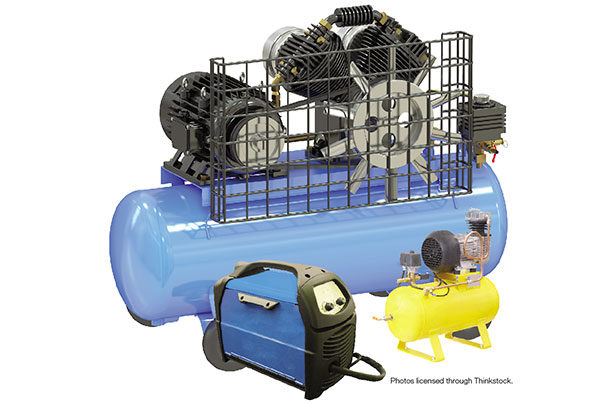Most small inexpensive consumer air compressors can operate short-burst tools, such as an air brush or brad nailer.
The entry level is really not a compressor but an inflator, which has no storage tank at all. Air from the piston flows straight to the intended item to be inflated, thus the name. Inflators can fill a car tire, but they can take up to 20 minutes to reach the correct pressure. The trade-off is that they are inexpensive and lightweight.
Small pancake air compressors are much more powerful and, yes, expensive. They are small (usually with a 1-gallon storage tank) and weigh less than 20 pounds. They are easy to store and highly portable. They are oil-free and have no belts, so they are mostly maintenance-free. Oil-free also means they are noisy for the amount of work they can handle.
Hot-dog compressors are popular with hobbyists and homeowners because they are powerful enough to operate an air brush or nailer. Their long single tanks give them more capacity than pancake models, and they are also heavier, of course. Again being oil-free, they are low-maintenance and loud.
If you are a do-it-yourselfer, a twin-stack compressor can be a great choice. Twin tanks mean they store more air than the designs already discussed. This means the compressor runs less for equally challenging jobs. Twin compressors are portable, but some models can weigh 70 pounds or more, so they can be more of a challenge to move.
A portable single-stage air compressor is a handy tool to have for folks who run air tools like nailers more frequently. Models are available as either gasoline or electric motors, and larger compressors mean they can be a great “little brother” to have around the farm.
I have a 30-gallon compressor in my garage. It is handy to fill a low tire and, even with its larger size, can find its way into the pickup for an emergency air source in the field.
Most farms need at least a stationary single-stage air compressor for affordable air on an occasional basis. A variety of sizes and features exist at this level of performance. Knowing what you are using the compressor for and thinking about how your needs might grow in the future are important pieces to consider when selecting your next air supplier.
Motors of single-stage compressors generally range from 2 to 5 horsepower. While a 5-hp model isn’t necessarily better than a 2-hp model, the extra power does mean you can create more cubic feet per minute. This will allow you to run more heavy-duty air tools or multiple air tools at once.
How much is enough? Start with the tools you currently have and what their needs are. Dropping below that amount will certainly give poor results.
Voltage options for single-stage compressors are threefold: 120/240v, 208-230v or 230v. What is your current wiring status? Match your purchase to what you currently have or what you think you will need in the future. A regular 120/240v unit will plug into a household outlet, so they are easiest to install. If you want to upgrade to a higher voltage and you do not have an existing outlet, your best bet is to get a licensed electrician to install your power source.
The pump is the most important piece of the compressor as a unit, as it does the actual work of compressing the air. Most pumps use oil, and that oil level needs to be checked and serviced from time to time.
If the pump is overworked, it can overheat and expire prematurely. To help with this, look for a compressor with a V-design pump. This style minimizes vibration, improves cooling – and thus has a longer life in your shop.
If you are running air tools with serious cubic-feet-per-minute requirements, you’ll want to step up to a two-stage or rotary screw compressor. Two-stage compressors are similar to a single in that they compress air with a piston but, instead of sending the compressed air directly to the storage tank, the air flows to an intercooler and then to a second piston for further compression.
This design allows the machine to hold more air at a higher pressure. For example, a single-stage compressor with an 80-gallon tank will hold 83 cubic feet of air at 100 psi. In comparison, a two-stage compressor with an 80-gallon tank can deliver 120 cubic feet of air at 150 psi.
Consequently, a two-stage compressor can easily maintain a header pressure of 125 psi. This is ideal if your air tool requires 90 psi at the end of the hose. A single-stage will allow the header pressure to drop below 90 psi, which will result in about 70 psi at the hose end.
The big boy on the block is the rotary screw compressor. You are probably most familiar with these units, as they appear on construction sites running larger-volume-gulping tools such as jackhammers, but shop models exist. They operate by rotating and counter-rotating opposed rotors or screws that trap air between the screw fins and drive it through under pressure.
Because of the simplicity of their design, they are able to provide air in a 365-day, seven-days-a-week and 24-hours-a-day setting. They are mostly for industrial settings and generally are powered by three-phase power or large diesel engines.
No matter what you needs are, a correctly sized air compressor will give you years of service and will quickly become one of the handiest items on your farm. ![]()
Andy Overbay holds a Ph.D. in ag education and has more than 40 years of hands-on dairy and farming experience.
PHOTO: Variety of air compressors. Photos licensed through Thinkstock.

-
Andy Overbay
- Extension Agent
- Virginia Cooperative Extension
- Email Andy Overbay











